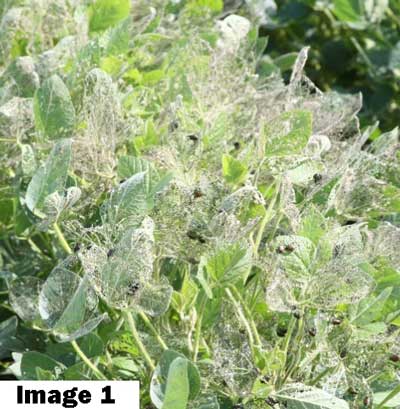
- Japanese beetles can be very hard to kill.
- Learn a little of the biology of Japanese beetles to help manage populations.
- Consider product characteristics when selecting insecticides for use against Japanese beetles.
IntroductionAn individual was once heard to remark that "we really don't kill Japanese beetles, we just chase them from field to field." There is actually a surprising amount of truth to this comment. Japanese beetles can be very hard to kill. Even when we kill a lot of them, they seem to quickly repopulate many fields. In order to effectively manage this pest, we need to learn what makes them so tough, what are the best weapons and management techniques available for our use, and how much should we adjust our expectations for effective beetle management.
Pest Features
Japanese beetles have some features that make them different from other pests in soybeans. Beetle emergence is not as synchronous as it is for some other pests, like northern masked chafer (beetles), for example. Japanese beetles often emerge over a period of several weeks, so just when you think you've seen the peak population, more beetles can be emerging from the soil and adding to the damage.
Japanese beetle populations are usually patchy, with heaviest concentrations often near field edges. (This is especially true in corn fields.) If you don't do a thorough job of field scouting, you can be misled into either believing that the beetle population is much higher or much lower than it really is. One of the reasons for the "clumped" field distribution of Japanese beetles is that the first beetles to arrive in a field start to feed and then release an aggregation pheromone. This pheromone attracts more beetles to the area. Japanese beetles feed near the top of soybean plants, resulting in frequent overestimation of damage.
Most of our commercial insecticides are synthetic pyrethroids. These products kill insects through both contact and ingestion. However, the hard exoskeleton (outer shell) of the Japanese beetle resists penetration of insecticides, limiting the amount of contact kill that occurs. The synthetic pyrethroids also have repellent effect with insects like Japanese beetles. Since these beetles are quite mobile, they really do avoid the pyrethroid sprays and spray residue on leaves, thereby also limiting ingestion of these insecticides.
Japanese beetles have numerous food sources in addition to soybean leaves and corn silks. The beetles can readily move between these food sources. We can spray a field, chase out the Japanese beetles, and then have the beetles rapidly repopulate the field after the insecticide wears out, or when new soybean leaves or corn silks emerge.
Insecticide Features and Selection*
There are two main groups of insecticides available for foliar application to corn and soybeans, the synthetic pyrethroids (Group 3A) and the organophosphates (Group 1B). In addition, there are a few other groups, like the neonicotinoids (Group 4A), that make up a minor part of the market by volume. Interestingly, in hot weather both activity and residual activity of most synthetic pyrethroids goes down. Activity of organophosphate insecticides tends to increase but residual activity drops off considerably. So, we have a tough insect in the Japanese beetle and our primary weapons are made less effective in hot weather. Sevin (Carbaryl – Group 1A) used to be used against Japanese beetles but it is very toxic to bees and is seeing reduced usage.
While it is helpful to manage our expectations for control of Japanese beetles, there are a few things to consider when selecting insecticides. Although most synthetic pyrethroid insecticides are rendered less effective in hot weather, Asana XL and bifenthrin (found in Triple Crown, Hero, Capture – for Corn, and others) tend to have more heat stability. Also consider trying insecticide combination products, especially those that contain two different insecticide groups. This may include products, like Cobalt Advanced, which contains chlorpyrifos (1B) and lambda-cyhalothrin (3A), and should not flare spider mites in soybeans. Endigo ZC is another product to try, although efficacy against Japanese beetles has only been observed on a limited basis. It contains lambda cyhalothrin (3A) and thiamethoxam (4A). Products containing more than one insecticide group are also believed to be better for managing development of resistance.
*Mention or omission of product names here should not be regarded as endorsement or lack of endorsement. Product names are mentioned as examples.
Contact your FS Crop Specialist for your agronomic information.

Image 1: Severe damage from Japanese Beetle in soybeans
Image 2: Japanese Beetles attract eachother and feed in groups